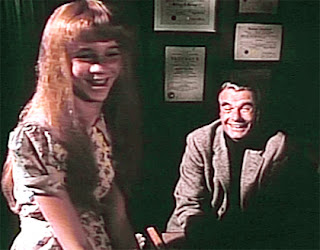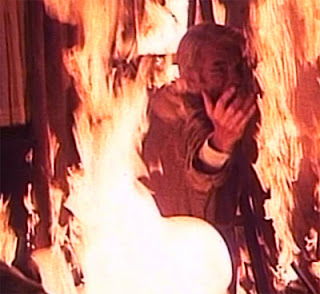Now Playing: How Awful About Allan (1970)
Pros: Good, veteran "suspense" cast; Effective (but brief) dream sequences; Clever allusion to Psycho at the very end
Cons: Perkins' character is hard to sympathize with; Unmasking of the culprit is anticlimactic
Pros: Good, veteran "suspense" cast; Effective (but brief) dream sequences; Clever allusion to Psycho at the very end
Cons: Perkins' character is hard to sympathize with; Unmasking of the culprit is anticlimactic
Note to my readers: After recently reading director Curtis Harrington's very entertaining memoir, Nice Guys Don't Work in Hollywood (more info below), I wanted to review one of his movies sooner than later. Harrington's Queen of Blood appealed, since, a.) I haven't reviewed any sci-fi in awhile; b.) it's also a nifty horror story, and so fits right into the Halloween high season; c.) I hadn't seen it for some time; and d.) it was readily available through Amazon Instant Video. Or so I thought. I fired up my networked Blu-ray player, searched for Queen of Blood, and promptly got a "Video currently unavailable" message. It had been there just a week ago when I checked. Being just a dumb, naive consumer who wants to watch what he wants to watch, I am getting soooo tired of these licensing follies (as are quite a few other folks out there). At any rate, I'm nothing if not flexible, so I quickly pivoted to a backup, How Awful About Allan, a pretty decent thriller and perhaps even more fitting for Halloween. You're welcome.
 |
| A thoroughly bummed-out Allan (Anthony Perkins) succumbs to hysterical blindness. |
Fast forward 8 months. Allan is ready to be released from the mental hospital. In a bit of exposition, Allan's doctor (William Erwin) reminds him that his blindness is psychosomatic, probably brought on by shock and guilt over his father's death and his sister's disfigurement. In his therapy, Allan has owned up to the doctor about his resentment of his sister's special relationship with his high achieving father, and in so doing has begun to deal with the guilt. The doctor reassures him that it was an accident-- of course he didn't mean to put the combustible paint so close to the heater in his father's room (hmmmmmm…..) And, he adds, Katherine has done well with her injuries-- the appliance she wears over her burn scars is "barely noticeable." Allan's eyesight has improved marginally -- he can see colors and shapes -- but he's still legally (if not somatically) blind. (In a shot from Allan's POV, we see the indistinct features of the doctor as he talks to his patient. The effect is like looking at someone behind a thick pane of leaded glass.) Allan listens stoically, if not quite believing everything the shrink is telling him. It's time to go home again…
Katherine picks him up from the hospital and drives him home. As they get out of the car, Allan pauses and looks up in the direction of the second story where the tragedy occurred. In a POV shot, only the indistinct outlines of the house are visible. Then it switches to a clear shot of the second story windows, which still bear the scorch marks of the fire. (If I'd been Allan's doctor, I think I would have recommended a change of scenery, but then, that's probably why I'm just a blogger, damn it!) As Katherine leads him up to the front porch, Allan stumbles against a sign in the yard, "Room for rent." "What's that?" he asks Katherine. "Oh, just a stick some neighbor kids left," she lies. Uh-oh, turbulence ahead!
 |
| Allan hears a shadowy figure whispering his name. |
Neighbor Olive (who we learn was once engaged to Allan) is, like Katherine, concerned for Allan's mental state. She persuades him to go along for a ride to the university (everyone in the small town seems to be employed there) to get him out of the musty house. Sitting in the car, Allan hears some students laughing on the library steps, and in his paranoid state, thinks they're laughing at him. Then, the creepy voice calls his name again and he sees a shape approaching the car window. Panicked, he takes the wheel, guns the car engine and drives off, running other cars off the road before crashing into a lamppost.
In the aftermath of the crash, Allan talks to Olive about the mysterious border no one ever sees, and the recent return of Katherine's former fiancee, Eric, who Olive has seen, but who Katherine claims moved to Australia and hasn't come back. Allan puts two and two together, and comes up with Katherine and Eric in a "secret living arrangement in a narrow-minded university town." Allan starts grilling Katherine about the student renter and Eric. But that night, when Allan is nearly pulled down the steep stairs by the dark figure whispering his name, it appears there's more at work than just two lovers living secretly together under Allan's nose. With Allan out of the way, the secret living arrangement might not have to be so secret.
 |
| Three creepy men in black witness Allan's car crash. A trio of red herrings, or something else? |
After this, Katherine and Olive tag team up on Allan to convince him to go back to the hospital. Allan is resigned to it, but before he can pack up, the shadowy figure strikes again. Who's trying to drive poor Allan mad, or worse yet, trying to kill him? The mysterious student boarder? Katherine's estranged fiancee Eric? What's a poor paranoid former mental patient to do?
In a way, this Aaron Spelling-produced TV movie is almost done in by its stellar cast. One could be forgiven for expecting great things of a production starring "Psycho" Anthony Perkins and Julie Harris of "The Haunting" fame. What you get is a competent, low-key thriller with some genuinely creepy moments, several dull stretches, and an effective music track by Laurence Rosenthal that keeps the viewer uneasy even during the dull parts.
To viewers raised on a diet of egregious TV gore like Dexter and The Following, How Awful About Allan no doubt will seem hopelessly staid and genteel. It's a slow-building neo-Gothic that features a "heroine" in the form of the gaunt, habitually nervous Anthony Perkins. There are no shocks to speak of, but rather just some well-crafted, dark-at-the-top-of-the-stairs spooky atmosphere for Anthony's character (and presumably the audience) to shiver at. The unease is effectively supplemented by POV shots from Allan's near-blind perspective. The dark at the top of the stairs is scary enough, but when all the figures you encounter, even in broad daylight, are indistinct shapes, even normal every-day life can get real scary real fast.
 |
| In the fevered dream sequence, young Katherine (Jeannette Howe) and Allan's father Raymond (Kent Smith) share a jolly, malicious secret. |
But even as we're tempted to sympathize with poor Allan, the character is at the same time maddeningly obtuse and unappreciative. As Katherine and Olive hover around him, fixing him meals, taking him on drives, and almost desperately trying to do right by him, he pouts and confronts and retreats to his room to spew his paranoid rants into his tape recorder. It gets to the point where even the most patient, forbearing viewer must be tempted to cheer for the shadowy figure to pull Allan's scrawny frame down the stairs and break his neck.
Given that there are only a handful of characters in the movie and the few red herrings are weak, the denouement is unsurprising and disappointing. But don't be tempted to shut it off before the end credits. The final minute or so is a wonderful, eccentric homage to Perkins' Psycho role, and saves the movie from what otherwise would have been a blah ending.
In addition to the star-power presence of Perkins and Harris, Joan Hackett is well cast as the kindly but unappreciated Olive. If you've seen any TV from the '60s and '70s, you've probably seen Joan. She was attractive without being Hollywood "beautiful," which allowed her to get roles that highlighted her versatility, from westerns to thrillers to sci-fi and everything in between. Tragically, she died of cancer in 1983 at the very young age of 49.
In his memoir Nice Guys Don't Work in Hollywood, director and ever-aspiring auteur Curtis Harrington said of the production, "This television experience was a relatively painless and even enjoyable one. I thought I was only killing time and making a few bucks between real work. If only I had known." (Curtis Harrington, Nice Guys Don't Work in Hollywood: The Adventures of an Aesthete in the Movie Business, Drag City Inc., 2013.)
Harrington is one of the more interesting directors that the average film fan has maybe-possibly-probably never heard of. His journey from a gangly middle class film buff, to experimental filmmaker, to hobnobber with such luminaries as Christopher Isherwood, Truman Capote and James Whale, to feature film director, to frustrated TV director, is an interesting one to say the least! Along the way, he made such fascinating and varied films as Night Tide (his ultra low budget feature debut with Dennis Hopper released in 1961), the Roger Corman-produced Queen of Blood (1966; with Hopper and Basil Rathbone), Games (1967; with Simone Signoret and James Caan), What's the Matter with Helen (1971; with Debbie Reynolds and Shelly Winters), and, to his everlasting regret, Devil Dog: Hound of Hell (TV movie with Richard Crenna and Yvette Mimieux; 1978).
How Awful was Anthony Perkins' first TV movie, and Harrington was worried that the actor would be uncomfortable with the rushed shooting schedule. But Harrington was relieved to find out that his leading man was the consummate professional. To achieve more realism, Perkins had opaque contact lenses made and wore them every day to the set, so that his blindness was authentic. Julie Harris and Kent Smith were also involved in scenes that were a little too authentic for comfort. In Harris' case, in a driving scene with a side-mounted camera, Julie forgot the camera was there and smashed it into a parked car. (Otherwise, Harrington noted, she was a "marvel of an actress and an angel of a person.")
 |
| Kent Smith does his own fiery stunt work in the opening scene. |
"I was fascinated by the way the special effects men smeared the walls with rubber glue, which is highly flammable but easily extinguished. The set was designed so that as the flames seem to engulf him, Kent would fall to his knees and crawl out the bottom of the set. It looked so real I was terrified that something had gone wrong during filming. But Kent emerged from the flames smiling and unsinged." [Ibid.]Harrington may have viewed How Awful About Allan as nothing more than a pleasant diversion between "real work," but it's a very competent, atmospheric thriller made all the more enjoyable with the presence of top-flight professionals Anthony Perkins, Julie Harris and Joan Hackett. Fortunately, it's widely available online and on DVD.
Where to find it:
Amazon Instant Video
Oldies.com
A "How Awful About Allan" sampler:



No comments:
Post a Comment